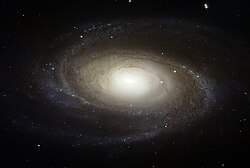Messier 81

| |
| A Hubble Space Telescope (HST) image of Messier 81 | |
| Data pengamatan Epos J2000 | |
|---|---|
| Rasi bintang | Ursa Major[3] |
| Asensio rekta | 09j 55m 33.2d[4] |
| Deklinasi | +69° 3′ 55″[4] |
| Diameter sudut (V) | 26.9 × 14.1 moa[4] |
| Magnitudo semu (V) | 6.94[5][6] |
| Ciri-ciri | |
| Jenis | SA(s)ab,[4] LINER[4] |
| Astrometri | |
| Kecepatan radial heliosentrik | −34 ± 4[4]km/s |
| Pergeseran merah | −0.000113 ± 0.000013[4] |
| Kecepatan galaktosentrik | 73 ± 6[4] km/s |
| Jarak | 118 ± 04 Mly (36,18 ± 1,23 Mpc) |
| Sebutan lainnya | |
Messier 81 atau M81 dikenal juga dengan NGC 3031 atau Galaksi Bode merupakan galaksi spiral yang berjarak sekitar 12 milyar tahun cahaya dari bumi, yang berada pada rasi bintang Ursa Mayor. Karena jaraknya yang relatif dekat dengan Bumi, ukurannya yang besar, serta inti galaksi aktit (yang memiliki lubang hitam supermasif dengan massa 70 juta M☉)[8], Messier 81 telah dipelajari secara ekstensif oleh para astronom profesional, serta menjadi target yang populer bagi astronom amatir.[9]
Penemuan
Messier 81 ditemukan pertama kali oleh Johann Elert Bode pada tahun 1774.[10] Akibatnya galaksi ini kadang disebut "Galaksi Bode". Pada tahun 1779, Pierre Méchain dan Charles Messier kembali mengidentifikasikan objek tersebut dan memasukkannya dalam katalog.[10]
Referensi
- ^
Jensen, Joseph B.; Tonry, John L.; Barris, Brian J.; Thompson, Rodger I.; Liu, Michael C.; Rieke, Marcia J.; Ajhar, Edward A.; Blakeslee, John P. (2003). "Measuring Distances and Probing the Unresolved Stellar Populations of Galaxies Using Infrared Surface Brightness Fluctuations". Astrophysical Journal. 583 (2): 712–726. arXiv:astro-ph/0210129
 . Bibcode:2003ApJ...583..712J. doi:10.1086/345430.
. Bibcode:2003ApJ...583..712J. doi:10.1086/345430.
- ^ Karachentsev, I. D.; Kashibadze, O. G. (2006). "Masses of the local group and of the M81 group estimated from distortions in the local velocity field". Astrophysics. 49 (1): 3–18. Bibcode:2006Ap.....49....3K. doi:10.1007/s10511-006-0002-6.
- ^ Dreyer, J. L. E. (1988). Sinnott, R. W., ed. The Complete New General Catalogue and Index Catalogue of Nebulae and Star Clusters. Sky Publishing Corporation / Cambridge University Press. ISBN 0-933346-51-4.
- ^ a b c d e f g h i j k "NASA/IPAC Extragalactic Database". Results for NGC 3031. Diakses tanggal 2006-11-10.
- ^ "SIMBAD-M81". SIMBAD Astronomical Database. Diakses tanggal 2009-11-28.
- ^
Armando, Gil de Paz; Boissier, Samuel; Madore, Barry F.; Seibert, Mark; Joe, Young H.; Boselli, Alessandro; Wyder, Ted K.; Thilker, David; Bianchi, Luciana; Rey, Soo-Chang; Rich, R. Michael; Barlow, Tom A.; Conrow, Tim; Forster, Karl; Friedman, Peter G.; Martin, D. Christopher; Morrissey, Patrick; Neff, Susan G.; Schiminovich, David; Small, Todd; Donas, José; Heckman, Timothy M.; Lee, Young-Wook; Milliard, Bruno; Szalay, Alex S.; Yi, Sukyoung (2007). "The GALEX Ultraviolet Atlas of Nearby Galaxies". Astrophysical Journal. 173 (2): 185–255. arXiv:astro-ph/0606440
 . Bibcode:2007ApJS..173..185G. doi:10.1086/516636.
. Bibcode:2007ApJS..173..185G. doi:10.1086/516636.
- ^ "SIMBAD Astronomical Database". Results for NGC 3031. Diakses tanggal 2006-11-10.
- ^ Devereux, N.; Ford, H.; Tsvetanov, Z.; Jocoby, J. (2003). "STIS Spectroscopy of the Central 10 Parsecs of M81: Evidence for a Massive Black Hole". Astronomical Journal. 125 (3): 1226–1235. Bibcode:2003AJ....125.1226D. doi:10.1086/367595.
- ^ O'Meara, S. J. (1998). The Messier Objects. Cambridge University Press. ISBN 0-521-55332-6.
- ^ a b Jones, K. G. (1991). Messier's Nebulae and Star Clusters (edisi ke-2nd). Cambridge University Press. ISBN 0-521-37079-5.
